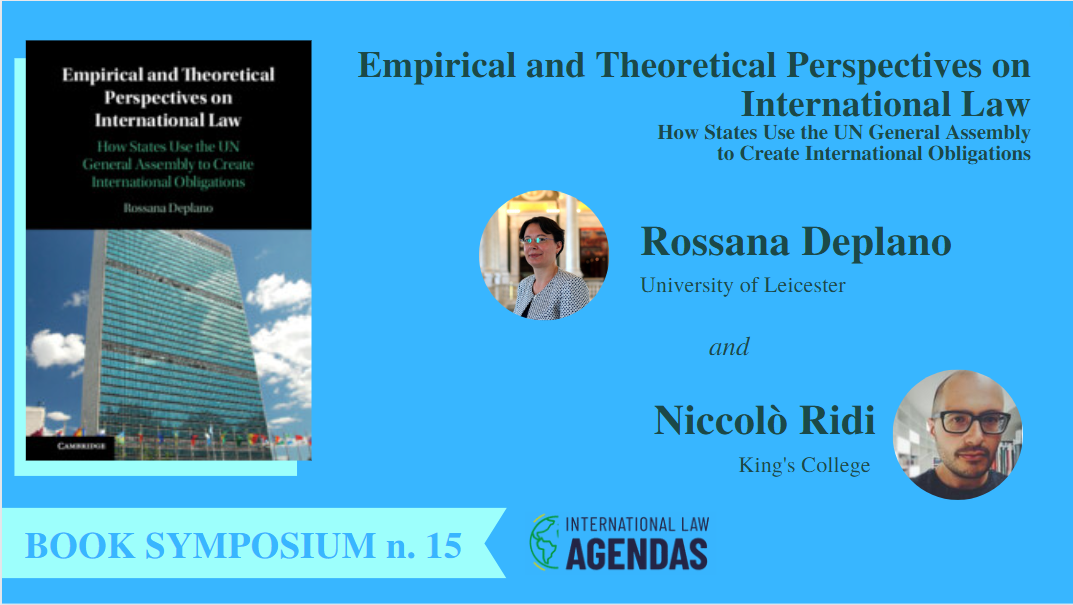Rossana Deplano’s book defies easy descriptions. Its complexity starts on the cover—more specifically, in the relationship between its title and its subtitle. The first part of the title, Empirical and Theoretical Perspectives on International Law, suggests that this will be a ‘method’ book. The second, How States Use the UN General Assembly to Create International Obligations, indicates that the object of analysis will be the United Nations General Assembly (UNGA), and more specifically the way in which it is used by States to create international obligations. In this review, I would like to offer some thoughts on the concept of ‘legal significance’ employed in the book, and, in the process, highlight some aspects of the contribution made by Deplano, which, I submit, goes beyond the specific subject matter of the book itself.
Titles, as a scholar I consider a mentor once told me, need not so much be snappy as descriptive, and this title certainly delivers on that front. However, it also undersells the book by some measure. On the one hand, the book is the product of a painstaking study not just of the material normative output of the UNGA, but rather of the processes by which these are reached, as well as their afterlife. On the other hand, it tackles a topic that has been generally—though not exclusively—treated in a rather traditional fashion with a sophisticated analysis building on a demonstrably solid research methodology and, in so doing, makes a distinct contribution to the empirical study of the output—normative or otherwise—of international organizations. It is an immensely rewarding read which will prove influential.
As mentioned before, the book is far richer than what the title suggests. The introductory chapter, for example, goes beyond what its title promises. In providing an overview of the role and functioning of the UNGA, it dismisses—curtly, but overall tersely—functionalism as the only or best explanatory model, and closes with with an assessment of the UNGA’s degree of autonomy from the member States. The next four chapters are instead devoted to the legal significance of resolutions, at their adoption stage, within domestic legal systems and in ‘international practice’, a notion which restricts ‘to the use that states make of resolutions before selected international courts and tribunals’ (p. 152). By doing so, however, they also contribute to a much broader debate. Thus, Chapter 2, focusing on the processes of text-formation at the UNGA, is at the same time a rigorous legal study on the dynamics of law-making by international organizations and an intriguing methodological foray into the merits of combining close reading with large-n analysis on textual data. Similarly, Chapter 3, on ‘The Legal Significance of Resolutions within Domestic Legal Systems’, similarly contributes to the broader debate concerning the relationship between international law and domestic law, as well as with the classical, but still challenging concept of obligation in international law. Chapter 4, on ‘The Legal Significance of Resolutions in International Practice’, contributes to the debate on the identification of those manifestations of state will and conduct that may carry some meaning for the purpose of law ascertainment (at para 35), as well as to the discussion about the argumentative and legitimizing function of international law.
The final substantive chapter ‘revisits’ the concept of legal significance. In this reviewer’s opinion, this concept is, from a theoretical perspective, the most problematic aspect of the book. There is no arguing that the notion avoids some of the pitfalls inherent in the use of other terms, and ‘normativity’ in particular. An argument could certainly be made that the latter notion has lent itself to the less nuanced and—to quote page 1—‘rather formalistic’, approaches adopted in the more traditional studies that the author seeks to improve on with her approach. In this regard, the author is coherent as she is clearly not interested in making a specific claim as to the nature of UNGA resolutions within the theory of sources, or in taking Article 38(1) of the ICJ Statute as a reference point. Still, it is worth pointing out that such sources-oriented approaches are no longer dominate the study of the inner workings, function, and output of international organizations. Far more nuanced approaches to the problem of normativity exist in the context of the study of international organizations in both international relations and international law scholarship. This is an area which may have called for additional engagement with both analytical jurisprudence and constructivist international relations scholarship.
However, the author is also in good company. The concept of ‘legal significance’ has been used in traditional studies such as the 1966 book-length treatment of the issue by Asamoah, which, by way of a short digression into the history of ideas, built on a doctoral thesis supervised by Wolfgang Friedmann and examined, inter alia, by Louis Henkin. The concept was also used by Samuel Bleicher in an early study that has been recognized as a forerunner in the field of empirical legal studies, and which has inspired more recent work on the normative output of international organizations.
To an extent—and this is, to my mind, another area in which the book sells itself short—the entirety of this study may be seen as an attempt to clarify to what the notion itself—that is, the notion of legal significance—amounts. At the theoretical level, the author hits the nail on the head by maintaining that the it must, at the same time, be separated from the (historically less helpful) concept of ‘effects’ and be seen as multi-dimensional and layered. This is because the legal significance is different depending on ‘the circumstances surrounding the decision to cite resolutions’ (p. 185), as well as depending on the actors that do so. By doing so, Deplano effectively demonstrates that whatever the notion of legal significance may amount to, it certainly cannot be considered a binary and objective concept.
The merits of Deplano’s monograph as an ‘international law book’ are therefore undeniable. But, once again, its merits go beyond that, and, as a scholar that shares with its author an interest in empirical approaches to the study of international law, I find it imperative to draw attention, if briefly, to its research design section. Its importance is not limited to the potential of empirical research in opening up knowledge that has traditionally been the domain of a few privileged insiders. Rather, as one of the comparatively few monographs on international law that contains one such section, which is as rigorous as it is painstakingly and generously documented, and which will prove invaluable to scholars wishing to pursue similar research in the future.
—
See Deplano’s response.
Also see Sayapin and Barros‘ review.
-

Niccolò Ridi is Lecturer (Assistant Professor) in Public International Law at the Dickson Poon School of Law, King’s College London, and a Research Fellow in the Human Rights Nudge Project.





